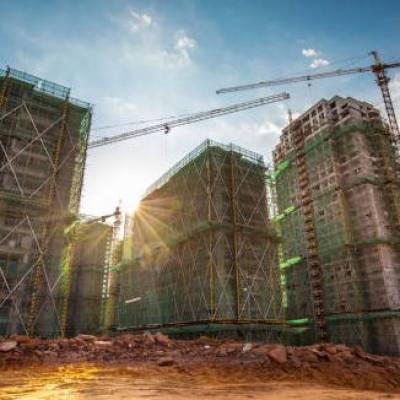- Home
- Real Estate
- The Real Estate Inventory

The Real Estate Inventory
Report card
Real estate is more a play of demand and supply, and issues related to supply are majorly in the micro-markets. Markets like Delhi, Mumbai, NCR or Chennai are all investor-driven, where almost 70 per cent of the inventory is taken by investors who want to flip their investment once the rate appreciates. ¨And, with the slowing down of the economy, real-estate demand has actually gone down, as a result of which investors were not able to liquidate and flip their investments,¨ points out Shubham Jain, Vice President, ICRA. So, as a result of second transactions not happening, investors were unable to sell their earlier investments and invest in new launches. This has affected new launches in a big way. Thus, not many projects are being launched in Mumbai and NCR now, and the focus has shifted to liquidating existing inventory.
At the state level, the Haryana Government has introduced an affordable housing policy, and 10-odd projects are being developed on that PPP model in Gurgaon. The Rajasthan Government has floated a similar PPP model where it will allocate land to the developer to build low-income (LIG) and mid-income (MIG) houses. While LIG housing will be given on a subsidised rate, developers can earn profits by selling MIG at market rates.
Execution zone
Godrej City Phase-I is a large property; of the 16 or so buildings that will come up, eight have been awarded to Man Infraconstruction for civil works. ¨The work order has been issued; we have received advances and started constructing the approach road and infrastructure,¨ says Parag Shah, Managing Director, Man Infraconstruction. ¨But the builder is awaiting some minor permission owing to which building work is yet to start.¨
Ahluwalia Contracts India Ltd (ACIL) has executed construction contracts worth over Rs 4,200 crore in the past three years (FY12-FY14). The company´s order book as on December 31, 2014, was Rs 3,321 crore, a rise from Rs 2,442 crore in 2013-14. Sharing the growth mantra despite a challenging year, Shobhit Uppal, Deputy Managing Director, ACIL, says, ¨Reducing exposure to the private sector and focusing on the government sector has been an instrumental strategy that helped the company at the right time.¨ At present, the company has six ongoing projects: International Convention Centre and Police Headquarters in Patna; IIM-Rohtak; DDA Residential Building and Head Office of Punjab National Bank in Delhi; and Income Tax Office, Mumbai.
The challenges
At present, there are two main issues facing the sector: Oversupply in micro-markets like Mumbai, Chennai and NCR, and affordability. As Jain puts it, ¨Prices have gone up and if we see the ratio of disposable income to EMIs, that is really going down every year. Even some reduction in interest rates may not help the sector till there is some rationalisation of pricing.¨
Another issue in real estate is that developers generate advances for one project and divert that money to buy land for the second project. So, the first project gets stalled and the contractor faces issues. To this, the new Real Estate Regulatory Bill, which has been proposed, states that there should be an escrow of at least 50 per cent of the advances, and this 50 per cent should be used for construction.
Procuring raw materials like sand - after the Supreme Court´s ban on sand mining - has been a major issue for this sector. Developers have adopted manufactured sand, for which there are not many factories. Water is another issue, especially in northern India and Bengaluru. As underground water cannot be used for construction, sourcing water in large quantities is a challenge.
REAL ESTATE: CW´S RECOMMENDATIONS
- Projects should be planned after a thorough study of demand and supply. There is a need to analyse prospective buyers for a proposed project and plan accordingly.
- As per reports, steps actioned in the right direction include:
- The Centre and state governments have taken several initiatives to encourage development in the sector.
- Maharashtra´s announcement of measures to bring in transparency and increase the ease of doing business in the sector.
- The Centre´s relaxation of norms to allow FDI in construction development; this should boost affordable housing projects and smart cities across the country.
- SEBI´s notification of final regulations that will govern REITs and infrastructure investment trusts (InvITs); this will enable easier access to funds for cash-strapped developers and create a new investment avenue for institutions and high-net-worth individuals and, eventually, ordinary investors.
- The Kerala Government´s move to make the process of securing permits from local bodies for housing construction smoother with the launch of a software called 'Sanketham'; this will ensure a more standardised and transparent procedure.
The Indian real-estate market is expected to touch $180 billion by 2020. The sector is expected to incur more NRI investments in the near future with reports suggesting that Bengaluru will be the most favoured property investment destination for NRIs, followed by Ahmedabad, Pune, Chennai, Goa, Delhi and Dehradun. Report card Real estate is more a play of demand and supply, and issues related to supply are majorly in the micro-markets. Markets like Delhi, Mumbai, NCR or Chennai are all investor-driven, where almost 70 per cent of the inventory is taken by investors who want to flip their investment once the rate appreciates. ¨And, with the slowing down of the economy, real-estate demand has actually gone down, as a result of which investors were not able to liquidate and flip their investments,¨ points out Shubham Jain, Vice President, ICRA. So, as a result of second transactions not happening, investors were unable to sell their earlier investments and invest in new launches. This has affected new launches in a big way. Thus, not many projects are being launched in Mumbai and NCR now, and the focus has shifted to liquidating existing inventory. At the state level, the Haryana Government has introduced an affordable housing policy, and 10-odd projects are being developed on that PPP model in Gurgaon. The Rajasthan Government has floated a similar PPP model where it will allocate land to the developer to build low-income (LIG) and mid-income (MIG) houses. While LIG housing will be given on a subsidised rate, developers can earn profits by selling MIG at market rates. Execution zone Godrej City Phase-I is a large property; of the 16 or so buildings that will come up, eight have been awarded to Man Infraconstruction for civil works. ¨The work order has been issued; we have received advances and started constructing the approach road and infrastructure,¨ says Parag Shah, Managing Director, Man Infraconstruction. ¨But the builder is awaiting some minor permission owing to which building work is yet to start.¨ Ahluwalia Contracts India Ltd (ACIL) has executed construction contracts worth over Rs 4,200 crore in the past three years (FY12-FY14). The company´s order book as on December 31, 2014, was Rs 3,321 crore, a rise from Rs 2,442 crore in 2013-14. Sharing the growth mantra despite a challenging year, Shobhit Uppal, Deputy Managing Director, ACIL, says, ¨Reducing exposure to the private sector and focusing on the government sector has been an instrumental strategy that helped the company at the right time.¨ At present, the company has six ongoing projects: International Convention Centre and Police Headquarters in Patna; IIM-Rohtak; DDA Residential Building and Head Office of Punjab National Bank in Delhi; and Income Tax Office, Mumbai. The challenges At present, there are two main issues facing the sector: Oversupply in micro-markets like Mumbai, Chennai and NCR, and affordability. As Jain puts it, ¨Prices have gone up and if we see the ratio of disposable income to EMIs, that is really going down every year. Even some reduction in interest rates may not help the sector till there is some rationalisation of pricing.¨ Another issue in real estate is that developers generate advances for one project and divert that money to buy land for the second project. So, the first project gets stalled and the contractor faces issues. To this, the new Real Estate Regulatory Bill, which has been proposed, states that there should be an escrow of at least 50 per cent of the advances, and this 50 per cent should be used for construction. Procuring raw materials like sand - after the Supreme Court´s ban on sand mining - has been a major issue for this sector. Developers have adopted manufactured sand, for which there are not many factories. Water is another issue, especially in northern India and Bengaluru. As underground water cannot be used for construction, sourcing water in large quantities is a challenge. REAL ESTATE: CW´S RECOMMENDATIONS Projects should be planned after a thorough study of demand and supply. There is a need to analyse prospective buyers for a proposed project and plan accordingly. As per reports, steps actioned in the right direction include: - The Centre and state governments have taken several initiatives to encourage development in the sector. - Maharashtra´s announcement of measures to bring in transparency and increase the ease of doing business in the sector. - The Centre´s relaxation of norms to allow FDI in construction development; this should boost affordable housing projects and smart cities across the country. - SEBI´s notification of final regulations that will govern REITs and infrastructure investment trusts (InvITs); this will enable easier access to funds for cash-strapped developers and create a new investment avenue for institutions and high-net-worth individuals and, eventually, ordinary investors. - The Kerala Government´s move to make the process of securing permits from local bodies for housing construction smoother with the launch of a software called 'Sanketham'; this will ensure a more standardised and transparent procedure.




















